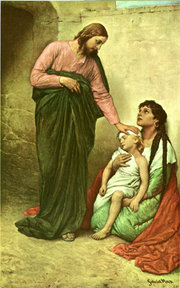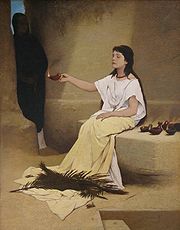
Gabriel von Max
Encyclopedia



Prague
Prague is the capital and largest city of the Czech Republic. Situated in the north-west of the country on the Vltava river, the city is home to about 1.3 million people, while its metropolitan area is estimated to have a population of over 2.3 million...
-born Austria
Austria
Austria , officially the Republic of Austria , is a landlocked country of roughly 8.4 million people in Central Europe. It is bordered by the Czech Republic and Germany to the north, Slovakia and Hungary to the east, Slovenia and Italy to the south, and Switzerland and Liechtenstein to the...
n painter.
He was born Gabriel Cornelius Max, the son of Czech
Czech people
Czechs, or Czech people are a western Slavic people of Central Europe, living predominantly in the Czech Republic. Small populations of Czechs also live in Slovakia, Austria, the United States, the United Kingdom, Chile, Argentina, Canada, Germany, Russia and other countries...
sculptor Joseph Max and Anna Schumann. He studied between 1855 and 1858 at the Prague Academy of Arts with Eduard von Engerth. His studies included parapsychology
Parapsychology
The term parapsychology was coined in or around 1889 by philosopher Max Dessoir, and originates from para meaning "alongside", and psychology. The term was adopted by J.B. Rhine in the 1930s as a replacement for the term psychical research...
(somnambulism, hypnotism, spiritism
Spiritism
Spiritism is a loose corpus of religious faiths having in common the general belief in the survival of a spirit after death. In a stricter sense, it is the religion, beliefs and practices of the people affiliated to the International Spiritist Union, based on the works of Allan Kardec and others...
), Darwinism
Darwinism
Darwinism is a set of movements and concepts related to ideas of transmutation of species or of evolution, including some ideas with no connection to the work of Charles Darwin....
, Asiatic philosophy, the ideas of Schopenhauer
Arthur Schopenhauer
Arthur Schopenhauer was a German philosopher known for his pessimism and philosophical clarity. At age 25, he published his doctoral dissertation, On the Fourfold Root of the Principle of Sufficient Reason, which examined the four separate manifestations of reason in the phenomenal...
, and various mystical traditions. The spiritual-mystical movement was emphasized by the writings of Carl du Prel, and the Munich
Munich
Munich The city's motto is "" . Before 2006, it was "Weltstadt mit Herz" . Its native name, , is derived from the Old High German Munichen, meaning "by the monks' place". The city's name derives from the monks of the Benedictine order who founded the city; hence the monk depicted on the city's coat...
painter Albert Keller
Albert Keller
Albert von Keller was a German painter.-Life and work:He was born at Gais, in Switzerland; he studied at the Munich Academy under Lenbach and Ramberg, and must be counted among the leading colorists of the modern German school. Travels in Italy, France, England and Holland, and a prolonged sojourn...
was also an influence.
His first large canvas was painted in 1858 while he was a student at the Prague Academy. He continued his studies at the Viennese Academy of Art with Karl von Blaas
Karl von Blaas
Karl von Blaas was the eldest representative of a family of distinguished Austrian painters. He was born at Nauders and studied at the Academy of Venice. In 1837 he received the Roman prize of the Academy of Venice...
, Karl Mayer, Christian Ruben
Christian Ruben
Christian Ruben was a German painter.Born in Trier, Ruben studied in Düsseldorf under Peter von Cornelius from 1823, and in 1826 settled in Munich, where he worked on the designs for the new stained glass windows for the Regensburg Cathedral and for a church in Auer...
and Carl Wurzinger. From 1863 to 1867 he studied at the Munich Academy with Karl Theodor von Piloty, and also Hans Makart
Hans Makart
Hans Makart was a 19th century Austrian academic history painter, designer, and decorator; most well known for his influence on Gustav Klimt and other Austrian artists, but in his own era considered an important artist himself and was a celebrity figure in the high culture of Vienna, attended with...
and Franz Defregger
Franz Defregger
Franz Defregger was an Austrian artist known mostly for his genre and history paintings....
. His first critical success was in 1867 with the painting "Martyr at the Cross": that painting transformed the "Unglücksmalerei" (dark palette) of Piloty into a religious-mystical symbolism using a psychological rendering of its subject.
He continued to use the dark palette of the Piloty school well into the 1870s, later moving toward a more muted palette, using fewer,clearer colors. From 1869, Gabriel von Max had his studio in Munich; in the summer, he was in the Ammerland at Starnberger Lake. From 1879-1883, Gabriel Max was a professor of Historical Painting at the Munich Academy; he also became a Fellow of The Theosophical Society. In 1900 he was ennobled and became a Ritter
Ritter
Ritter is a designation used as a title of nobility in German-speaking areas. Traditionally it denotes the second lowest rank within the nobility, standing above "Edler" and below "Freiherr"...
. He died in Munich in 1915.
His interest in anthropological studies also showed in his work. He owned a large scientific collection of prehistoric ethnological and anthropological finds: the collection now resides in the Stadtischen Reiss Museum in Mannheim
Mannheim
Mannheim is a city in southwestern Germany. With about 315,000 inhabitants, Mannheim is the second-largest city in the Bundesland of Baden-Württemberg, following the capital city of Stuttgart....
. At his residence in Starnberger Lake, Gabriel Max surrounded himself with a family of monkeys, which he painted often, sometimes portraying them as human. Max, along with his colleagues, often used photographs to guide painting. The great number of monkey photographs in his archive testify to their use as direct translation into his paintings. In 1908, his painting "The Lion's Bride" became celebrated, and was depicted in motion pictures as an hommage in the Gloria Swanson
Gloria Swanson
Gloria Swanson was an American actress, singer and producer. She was one of the most prominent stars during the silent film era as both an actress and a fashion icon, especially under the direction of Cecil B. DeMille, made dozens of silents and was nominated for the first Academy Award in the...
film, Male and Female
Male and Female
Male and Female is a 1919 silent film directed by Cecil B. DeMille. Its main themes are gender relations and social class. It is based on the J. M. Barrie play "The Admirable Crichton".-Plot:...
, (1919), directed by Cecil B. de Mille.
Gabriel von Max was a significant artist to emerge from the Piloty School, because he abandoned the themes of the Grunderzeitliche (genre and history), in order to develop an allegorical-mystical pictorial language, which became typical of Secessionist Art. Characteristic of the ethereal style of Gabriel Max is "The Last Token" (in the Metropolitan Museum), and "Light" (in the Odessa Museum of Western and Eastern Art, Ukraine).
External links
- Collection of Works by Gabriel von Max
- Period archives biography Retrieved 19-08- 2008
- Art Renewal Center Gallery Retrieved 19-08- 2008

